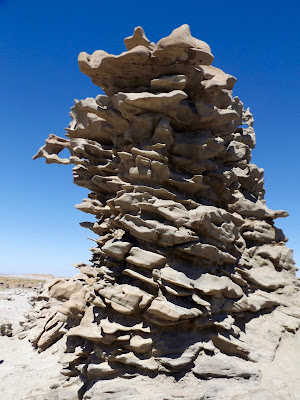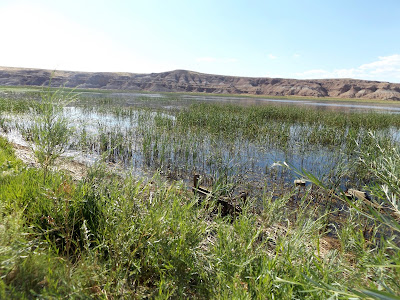July 25, 2016
Fantasmagorical! That's how I describe the shapes at Fantasy Canyon, a slice of Utah geology that looks as if a giant fashioned interwoven wax forms and then passed a torch over them until they were melted into blobs that are suspended in impossible-to-support convolutions.
The word canyon conjures an area larger than Fantasy encompasses, but it is well worth the visit to wander through such a unique geologic mystery. Even the señor, who speaks geology, had no explanation for those puzzling formations.
The surrounding dumpling-like hills all contain the same strata beneath their multi-colored bands; however, only at Fantasy Canyon has the erosion created such twisted shapes jutting out in fins and fingers that are seen nowhere else.
Much of it looks like stalagtites and stalagmites without the cave. . .
 |
| It was fun (and hot) hiking up and over the hills above the canyon and afforded us nice views of the expansive landscape down to and far beyond Fantasy Canyon. |
 |
| This is a common sight out there - many, many square miles of prairie dogs, pump jacks and sage brush. |
I am enchanted by the Green River: it seems so majestic as it finds its winding way through the Utah desert. In many places, one bank of the waterway is sere barren ground while the opposite side is lush with trees and grassy, swampy bottomland - miles and miles of it.
What Utah does best is sand, and that is apparent in the river; its channel is often filled with large sandbanks and islands.
Wildlife refuge . . .
We found the Ouray Wildlife Refuge to be one of the most fascinating we've visited. We traversed it from both sides of the river and found them to be extremely different from each other. First, we wandered along the east side of the refuge and were fascinated to find one bend of the river and a nearby bottom to be populated by several hundred white pelicans. I have never seen so many in one place; however, there was not much variety in the other water birds there.
We noted a few double-crested cormorants nearby and then spotted an impressive rookery in a huge bleached-white dead tree.
One walk along a dike that intersected another bottom was preceded by using insect repellent, which seemed only to encourage the swarms of mosquitoes and biting flies. We braved it as long as we could stand it, and finally fled back to the safety of the truck. It was hopeless to try to identify birds through binoculars; both hands were necessary to continually flail away at the hordes.
The Refuge on the opposite side of the river is extremely different: there the road meandered through miles of swampy bottomland atop dikes that allow adjoining thickly treed sections to be watered and then dried out.
There were huge numbers and great diversity of waterfowl on that side: we identified many, but missed many others because we failed to bring along our spotting scope on this trip - a big disappointment at times like that.
Using only binoculars, we saw American avocet, Canada goose, American coot, mallard, ruddy duck, great egret, snowy egret, common merganser, Clark's grebe, yellow-headed blackbird, Caspian tern, white-faced ibis, ring-billed gull, Franklin's gull, black-necked stilt, osprey and hordes of great blue herons. Also in that area, we got Wilson's warbler, red-tailed hawk and kestrel.
While scouting fishing access along the river, I spotted a cottontail that continued munching away at its breakfast despite our presence. Turning around, I was surprised to see another bunny, this time of the domestic variety, and then another . . . leaving me again with questions and no answers. Maybe we should have adopted them.
Everywhere we've gone in this region we've seen many horses - large herds in every environment from swamps to prairies.
Back in Vernal, we are impressed that the main highway through town is lined with scores of large containers of flowering plants, so many that a tank truck drives through to water them.
































No comments:
Post a Comment